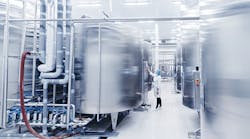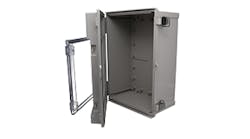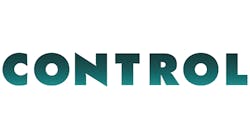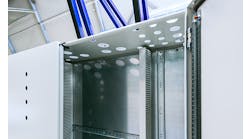Since the advent of the first IBM personal computer (PC) in the early 1980s, the PC has evolved into an essential tool for the modern manufacturing operation. Today, PCs based on Microsoft Windows operating systems and Intel microprocessors ("Wintel" architecture for short) serve to control manufacturing processes, collect and analyze data, and communicate meaningfully with human operators and with other networked plant management systems. In short, their ability to simultaneously address both deterministic automation tasks and less time-sensitive information management, communication and integration requirements has led to their widespread deployment across industry.
Sometimes, PCs used for industrial applications are fortunate enough to reside in the relative comfort of a control room adjacent to production operations. But more often than not, they're needed closer to the action—mounted on or near the machines and processes they control. And while manufacturing and other industrial operations continue to benefit from rapid advances in the broader PC market, commercial ones were never intended for the rigors of plant-floor operations. Indeed, using a naked "white-box" PC introduces a range of operational risks ranging from downtime to operator injury, any one of which can quickly swamp any savings realized at the outset.
To mitigate these risks, system designers have the option of specifying a sealed, industrially hardened computer that's ready to deploy in an industrial environment. Or, they can choose an appropriately sealed and hardened industrial enclosure into which a more general-purpose computer can be placed. Either approach can perform admirably when it comes to ensuring the integrity of routine operations, effectively isolating sensitive PC electronics from their surroundings. Longer term, however, the choice between an industrial PC and a hardened enclosure must take into account lifecycle costs, operational continuity and the accelerating pace of information technology innovation.
Minimum downtime
The foremost and most obvious operational risk that comes with using an unprotected commercial PC is that of downtime. The value of even an hour's worth of lost production—and potentially of in-process inventory that must be discarded—often crystallizes the value of a more robust solution in the mind of even the most budget-conscious operations manager. In particular, commercial PCs are vulnerable to the harsh operating conditions endemic to plant-floor environments, especially temperature extremes, water and other corrosive or even explosive substances.
While commercial PCs often include some sort of light-duty fan to dissipate heat, these often prove inadequate when it comes to the higher temperatures encountered in an industrial context. Further, they do nothing to address sudden changes in temperature. Indeed, sometimes it's not the absolute temperature that causes damage, but an abrupt drop that results in condensation in the computer and subsequent failure. The ingress of dripping or sprayed water, corrosive chemicals or gases also put unprotected electronics at risk.
To counter these threats, manufacturers of industrial enclosures use a variety of special seals and configurations to protect against drips and hose-directed sprays. Onboard heating and cooling systems ensure that electronics are kept within an optimal temperature range and that condensation is prevented. Purge systems are sometimes added to prevent the ingress of corrosive or explosive gases. Indeed, the common protective requirements for electronic equipment deployed in industrial environments have given rise to classification methodologies developed by a number of industry organizations, notably the National Electrical Manufacturers Assn. (NEMA) in the U.S. and the International Electrotechnical Commission (IEC) as shown in Table I.
| NEMA Classification | Comparable IEC Classification | Description |
| 4 | IP 66 | For indoor or outdoor use, providing "a degree of protection" to personnel against access to hazardous parts as well as a degree of protection of the equipment inside from solid foreign objects (falling dirt and windblown dust); ingress of water (rain, sleet, snow, splashing water, and hose directed water); and external formation of ice. |
| 4X | IP 66 | Similar to NEMA 4, with added protection against corrosion |
| 6 |
IP 67 |
Similar to NEMA 4, with added protection against water ingress when temporarily submerged |
| 12 | IP 55 | For indoor use, with protective measures oriented toward dripping and light splashing of water. |
| 13 | IP 65 | Similar to NEMA 12, with added protection against splashing and spraying of oil and non-corrosive coolants. |
Table 1: While not strictly equivalent, these NEMA and IEC IP (ingress protection) ratings are commonly used for PC and other enclosures intended for industrial applications.
Water, chemicals and other foreign matter aren't the only intruders that can wreak havoc on the continuous operation of electronic equipment. Electromagnetic and radio frequency interferences (EMI and RFI) from nearby electrical equipment can cause not only outright downtime but result in maddeningly intermittent problems that are particularly difficult to diagnose and resolve. To prevent these issues, a properly designed industrial enclosure acts as a Faraday cage, a conductive "shell" around the PC that effectively isolates it from its surroundings, and prevents disruptive RF/EM signals from entering—or escaping—the enclosure.
Another way that an industrial enclosure can help reduce downtime is with the inevitable eventuality of computer failure. While an industrially hardened computer should last longer than a protected commercial one (after all, that's a big part of the initial price premium), hardware failures do happen—sometimes six months down the road, sometimes six years. Industrial computers, on the one hand, are often relatively inflexible when it comes to repairs. Their sealed design may require a visit from the supplier's service technician or shipment back to the manufacturer. Restoring production quickly after a failure entails holding an expensive spare unit in inventory that grows increasingly outdated over time.
Contrast this with an industrial enclosure teamed with a commercial PC that can be quickly swapped out with a late-model version that's often more capable than the one it replaces (and is likely less expensive, too). The lower price point means lower inventory costs for carrying spares. Plus, a defective commercial PC would likely not be repaired at all, but simply tossed in the electronics recycling bin.
Safer, more secure operations
While the costs and implications of production downtime can be readily calculated, risks to operator safety—and its close cousin security—are perhaps more compelling. An industrial enclosure not only protects its contents from the world around it, but plays an important role in protecting human operators from harm.
For example, the same purge system that protects a PC from the ingress of corrosive gases can prevent a potentially explosive mixture from reaching an ignition source. Industrial enclosures are designed to prevent the ingress of fingers or misdirected screwdrivers that could result in electrical shocks. Further, industrial enclosures better facilitate the use of formal lock-out, tag-out methodologies that physically prevent inadvertent start-up of a machine or electrification of a circuit when maintenance tasks are being performed.
An unprotected commercial PC is also physically vulnerable to unauthorized access by naive or malicious persons. A locked industrial enclosure provides a first level of defense against unauthorized access and protects the PC's USB ports and other media drives. The choice of hinge design (internal vs. external), locking/latching mechanism, as well as material of construction (thick steel vs. thin composite materials) also contribute to physical security.
Productivity and agility
If avoiding downtime and improving operator safety and operational security aren't reasons enough to choose an industrial enclosure teamed with a commercial PC to address your plant-floor computing needs, consider the ways in which this flexible approach can both boost worker productivity today and responsiveness to changing needs down the road.
First, industrial enclosures come in a broad array of configurations designed to help plant-floor operators be more productive. This may include industrial casters designed to move the PC station around the floor, maintaining ready operator access as they physically move from task to task. Or the PC monitor enclosure itself might be mounted on a swing arm that can be optimally positioned to the needs of each individual operator.
Agility, on the other hand, refers to the ability to respond quickly to changing market demands or opportunities, and in this context, arises from the deliberate decoupling of investment in system components with relatively short lifecycles (the PC and its software) versus those elements designed to last much longer (the industrial enclosure itself). When new software is available that can bring desirable operational improvements but doesn't run on your aging PC, the upgrade path is straightforward and cost-effective as well.






